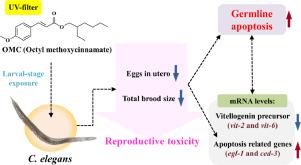Aquatic Toxicology ( IF 4.1 ) Pub Date : 2022-03-23 , DOI: 10.1016/j.aquatox.2022.106149 Chi-Wei Huang , Zhi-Ying Kung , Chia-Cheng Wei

|
Octyl methoxycinnamate (OMC) is a common UV filter found in personal care products such as sunscreen and cosmetics. However, OMC's presence in wastewater has raised concerns that it could potentially pollute aquatic ecosystems because of its limited biodegradability and its estrogenic disrupting properties. In this study, we investigated the environmental toxicity of OMC and its potential biomarkers using the nematode Caenorhabditis elegans. Our results showed that body length, eggs in utero, and total brood size decreased with increasing dose (experimental concentrations = 0, 1, 5, 10, 100, 500 μM for body length and eggs in utero, and 0, 5, 10 μM for total brood size) in C. elegans after L1 larval stage (the first larval stage for 0 – 12 hours post-hatching) larval stage exposure to OMC. The minimum effective concentrations were 1, 5, and 10 μM, respectively. Modeling results demonstrated that the threshold concentration of OMC inducing 10% inhibited eggs in utero was 0.33 μM (95.11 μg/L). Furthermore, germline apoptosis was induced in 10 μM OMC-treated worms (experimental concentrations = 0, 5, 10 μM). Decreased mRNA levels of vitellogenin-related genes (vit-2 and vit-6) and increased mRNA levels of apoptosis-related genes (egl-1 and ced-3) were observed in 10 μM OMC-treated C. elegans (experimental concentrations = 0, 10 μM), suggesting that reproductive toxicity was associated with decreased vitellogenin levels and germline apoptosis. In summary, our study shows that OMC is reproductively toxic and leads to reduced egg formation and decreased brood size in C. elegans by reducing vitellogenin levels and promoting germline apoptosis.
中文翻译:

紫外线过滤剂甲氧基肉桂酸辛酯引起与秀丽隐杆线虫的生殖细胞凋亡和卵黄原蛋白减少相关的生殖毒性
甲氧基肉桂酸辛酯 (OMC) 是一种常见的紫外线过滤剂,用于防晒霜和化妆品等个人护理产品。然而,OMC 在废水中的存在引起了人们的担忧,即由于其有限的生物降解性和雌激素干扰特性,它可能会污染水生生态系统。在这项研究中,我们使用线虫Caenorhabditis elegans研究了 OMC 的环境毒性及其潜在的生物标志物。我们的研究结果表明,随着剂量的增加,体长、子宫内的卵子和总育雏大小会减小(实验浓度 = 0、1、5、10、100、500 μM 的体长和子宫内的卵子,以及 0、5、10 μM对于总育雏大小)在秀丽隐杆线虫在 L1 幼虫期(孵化后 0-12 小时的第一个幼虫期)幼虫期暴露于 OMC 之后。最小有效浓度分别为 1、5 和 10 μM。建模结果表明,OMC 在子宫内诱导 10% 抑制卵子的阈值浓度为 0.33 μM (95.11 μg/L)。此外,在 10 μM OMC 处理的蠕虫中诱导生殖细胞凋亡(实验浓度 = 0、5、10 μM)。在 10 μM OMC 处理的秀丽隐杆线虫中观察到卵黄原蛋白相关基因(vit-2和vit-6)的 mRNA 水平降低和凋亡相关基因(egl-1和ced-3 )的 mRNA 水平升高(实验浓度 = 0, 10 μM),表明生殖毒性与卵黄原蛋白水平降低和生殖细胞凋亡有关。总之,我们的研究表明,OMC 具有生殖毒性,并通过降低卵黄原蛋白水平和促进生殖细胞凋亡来减少秀丽隐杆线虫的卵形成和育雏大小。











































 京公网安备 11010802027423号
京公网安备 11010802027423号